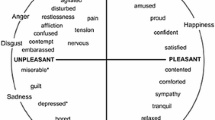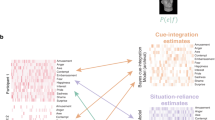Abstract
Understanding a person’s mental state is a key challenge to the design of Artificial General Intelligence (AGI) that can interact with people. A range of technologies have been developed to infer a user’s emotional state from facial expressions. Such bottom-up approaches confront several problems, including that there are significant individual and cultural differences in how people display emotions. More fundamentally, in many applications we may want to know other mental states such as goals and beliefs that can be critical for effective interaction with a person. Instead of bottom-up processing of facial expressions, in this work, we take a predictive, Bayesian approach. An observer agent uses mental models of an observed agent’s goals to predict how the observed will react emotionally to an event. These predictions are then integrated with the observer’s perceptions of the observed agent’s expressions, as provided by a perceptual model of how the observed tends to display emotions. This integration provides the interpretation of the emotion displayed while also updating the observer’s mental and emotional display models of the observed. Thus perception, mental model and display model are integrated into a single process. We provide a simulation study to initially test the effectiveness of the approach and discuss future work in testing the approach in interactions with people.
Access this chapter
Tax calculation will be finalised at checkout
Purchases are for personal use only
Similar content being viewed by others

References
Alfonso, B., Pynadath, D.V., Lhommet, M., Marsella, S.: Emotional perception for updating agents’ beliefs. In: 2015 International Conference on Affective Computing and Intelligent Interaction (ACII), pp. 201–207. IEEE (2015)
Calvo, R., D’Mello, S., et al.: Affect detection: an interdisciplinary review of models, methods, and their applications. IEEE Trans. Affect. Comput. 1(1), 18–37 (2010)
Clore, G.L., Ortony, A.: Psychological construction in the occ model of emotion. Emot. Rev. 5(4), 335–343 (2013)
Ekman, P., Friesen, W.V., O’Sullivan, M., Chan, A., Diacoyanni-Tarlatzis, I., Heider, K., Krause, R., LeCompte, W.A., Pitcairn, T., Ricci-Bitti, P.E., et al.: Universals and cultural differences in the judgments of facial expressions of emotion. J. Pers. Soc. Psychol. 53(4), 712 (1987)
Ekman, P., Rosenberg, E.L.: What the Face Reveals: Basic and Applied Studies of Spontaneous Expression using the Facial Action Coding System (FACS). Oxford University Press, New York (1997)
Elfenbein, H.A., Beaupré, M., Lévesque, M., Hess, U.: Toward a dialect theory: cultural differences in the expression and recognition of posed facial expressions. Emotion 7(1), 131 (2007)
Happy, S., Routray, A.: Automatic facial expression recognition using features of salient facial patches. IEEE Trans. Affect. Comput. 6(1), 1–12 (2015)
Izard, C.E.: Innate and universal facial expressions: evidence from developmental and cross-cultural research (1994)
Marsella, S.C., Pynadath, D.V., Read, S.J.: Psychsim: agent-based modeling of social interactions and influence. In: Proceedings of the International Conference on Cognitive Modeling, vol. 36, Citeseer, pp. 243–248 (2004)
Ortony, A., Clore, G.L., Collins, A.: The Cognitive Structure of Emotions. Cambridge University Press, Cambridge (1990)
Safdar, S., Friedlmeier, W., Matsumoto, D., Yoo, S.H., Kwantes, C.T., Kakai, H., Shigemasu, E.: Variations of emotional display rules within and across cultures: A comparison between Canada, USA, and Japan. Canadian Journal of Behavioural Science/Revue canadienne des sciences du comportement 41(1), 1 (2009)
Smith, C.A., Lazarus, R.S.: Emotion and adaptation (1990)
Tauber, S., Navarro, D.J., Perfors, A., Steyvers, M.: Bayesian models of cognition revisited: Setting optimality aside and letting data drive psychological theory
Whiten, A.: Natural Theories of Mind: Evolution, Development and Simulation of Everyday Mindreading. Basil Blackwell, Oxford (1991)
Author information
Authors and Affiliations
Corresponding author
Editor information
Editors and Affiliations
Rights and permissions
Copyright information
© 2016 Springer International Publishing Switzerland
About this paper
Cite this paper
Yongsatianchot, N., Marsella, S. (2016). Integrating Model-Based Prediction and Facial Expressions in the Perception of Emotion. In: Steunebrink, B., Wang, P., Goertzel, B. (eds) Artificial General Intelligence. AGI 2016. Lecture Notes in Computer Science(), vol 9782. Springer, Cham. https://doi.org/10.1007/978-3-319-41649-6_23
Download citation
DOI: https://doi.org/10.1007/978-3-319-41649-6_23
Published:
Publisher Name: Springer, Cham
Print ISBN: 978-3-319-41648-9
Online ISBN: 978-3-319-41649-6
eBook Packages: Computer ScienceComputer Science (R0)



